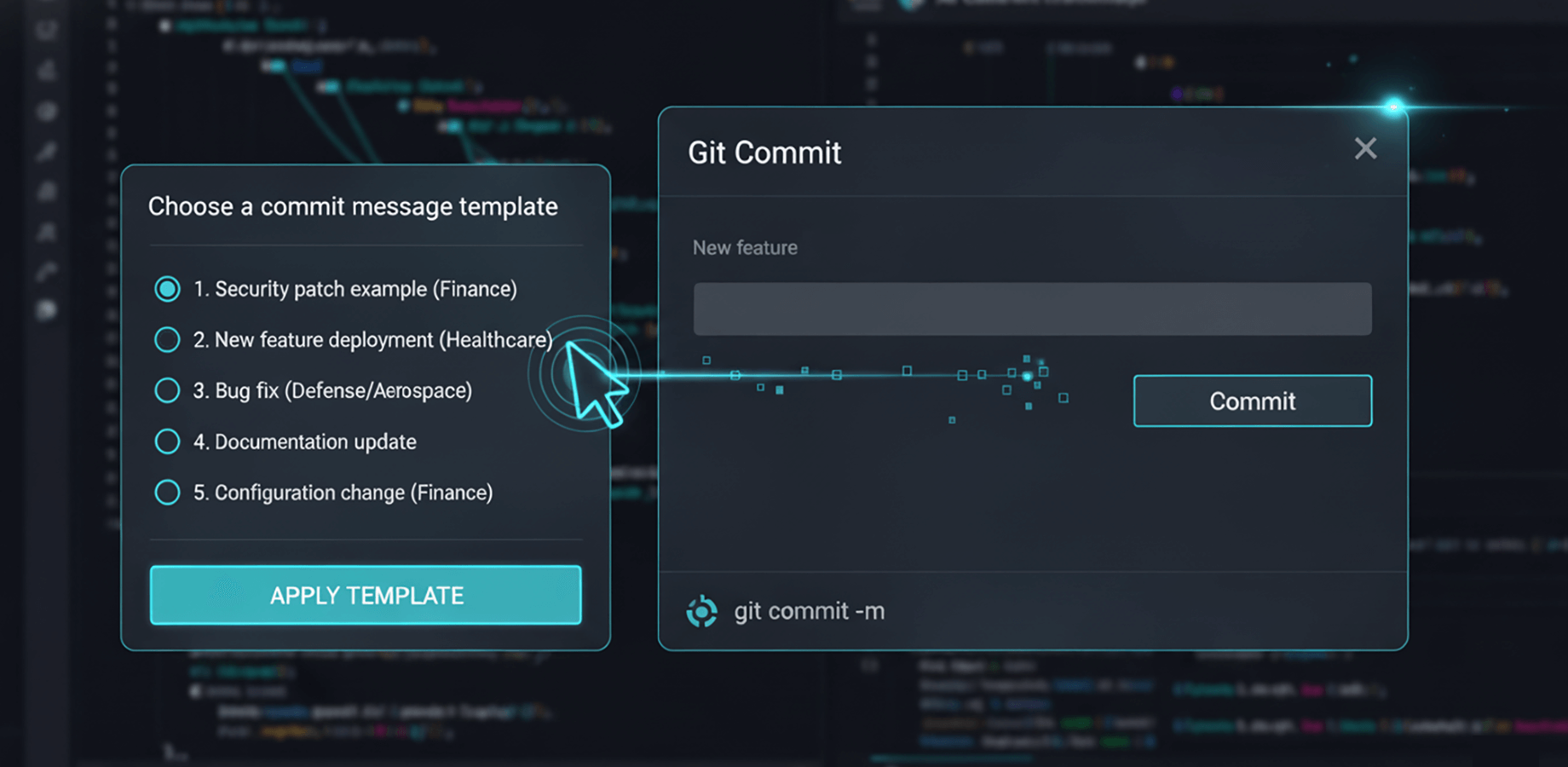Implementing any kind of department-wide convention is difficult, and that's especially true for software teams.
Whether you're a developer, adapting to your team's expected commit message standards, or you're an engineering manager looking to introduce new audit-ready rules across your developer organization, this Git commit message template collection will serve you well.
A consistent, audit-ready commit history is a foundation for traceability, audit readiness, and efficient collaboration, which are a must for teams working in regulated industries, like defense, healthcare, or finance.
But even in fast-paced software teams, commit messages that follow a predictable pattern help:
- Understand what changed and why, even after many years
- Automate or expedite releases, compliance reviews and audits
- Catch violations as early as commit time, using commit policies on developers local environments
In this resource, you’ll find practical Git commit message templates you can copy if you are a developer and not really sure what is expected from you.
Engineering managers and dev leads can use this as blueprint to create your team's Git commit message conventions.
Use and customize the Git commit templates below in your specific environment. Find notes on why they work and how to enforce them for automated compliance.
10 Git commit message templates to copy
1. Security patch example (Finance)
SEC-431 fix(crypto): update OpenSSL to 3.0.13 to address CVE-2025-231
✅ Why it works:
- Starts with a Jira work item key (SEC-431)
- Clearly marks the change type (fix)
- Uses a subsystem tag (crypto)
- References a CVE for audit traceability
This follows the "require Jira work item key" and "commit message length convention" rules.
2. New feature deployment (Healthcare)
HLT-2109: feat(api): add endpoint for patient medication history retrieval
Add new /api/v1/patients/{id}/medications endpoint returning medication list with timestamps and source system IDs.
Data privacy: returns only permitted fields, enforces authz (scope: medication:read), and enables audit logging for PHI access.
Tests: TEST-MED-101 (unit) and TEST-MED-201 (integration)
✅ Why it works:
- Connects to a feature type Jira work item (HLT-2109)
- Describes scope (api) and business intent (patient medication history)
- "feat" can signal a new capability for automated release notes
This commit message links the change to the Jira feature work item and clearly describes the new endpoint's scope and business intent so reviewers can understand the purpose without searching other systems.
It documents data-privacy controls and the required authorization scope to demonstrate how personal health information access is protected for auditors. By referencing test work items the message makes it easy for QA and compliance teams to locate unit and integration test artifacts.
Possible customization: mention delivery artifacts like a Postman collection and CI job that signals that automated validation is in place and the change is verifiable.
See how the DevOps team at Philips links source code change to Jira work items to make completed work visible.
3. Bug fix (Aerospace)
DEF-6789: fix(sensor): correct altitude data rounding in telemetry module Fix floating-point precision issue causing 0.3-meter discrepancy in altitude readings above 10,000 feet, violating mission planning accuracy requirements. Safety Impact: MEDIUM - Affects mission planning accuracy but not flight safety systems - No impact to flight control or collision avoidance systems Traceability: - Requirement: REQ-TELEM-042 (Altitude Accuracy) - Test cases: TC-ALT-001 through TC-ALT-016
✅ Why it works:
- Links to a tracked defect (DEF-6789), preventing feature changes in a bug-fix branch
- Contains precise technical correction
- Uses subsystem tag (sensor) for subsystem traceability
- Ensures commits/PRs that target a maintenance/hotfix workflow are actually linked to a Bug type work item
Defect traceability is a key compliance requirement in aerospace projects. This template includes an explicit safety impact assessment, aligning with DO-178C requirements. The Git commit message maintains traceability to requirements and could be customized to include test cases or configuration management details to support version control and change tracking.
Learn how EaglePicher, an aerospace contractor verifies code changes.
💡 Verify code changes in your Bitbucket repository
4. Documentation update (Defense)
ITAR-654 docs(crypto): update export control documentation for cryptographic modules Add ITAR classification markings and export control guidance to all cryptographic implementation documentation per DDTC compliance review findings. Documentation Updates: 1. Added ITAR classification headers to 47 source code files 2. Updated README.md with export control warning 3. Added EAR99 exemption notes for publicly available encryption algorithms Classification Details: - Cryptographic implementations using AES-256, RSA-4096: ITAR Category XIII(b)(1) - Key management protocols: ITAR Category XI(c)(10)
✅ Why it works:
- Tracks documentation changes under their own Jira work item
- Uses "docs" type for semantic clarity
- Easy to filter during release packaging
Documentation is part of the release, so commits should reflect that.
This commit adds ITAR classification headers and export-control guidance to cryptographic implementation documentation to address DDTC compliance findings.
The commit explicitly lists classification details as ITAR Category XIII(b)(1); key management protocols as ITAR Category XI(c)(10) so reviewers, legal, and release engineers can make informed decisions.
💡 How to verify my devs comply with commit message rules?
5. Configuration change (Finance)
CFG-222: chore(config): update AML rule thresholds to align with 2025 policy
✅ Why it works:
- "chore" identifies it’s not user-facing
- Keeps audit trail for rule or policy updates
- Connects directly to compliance work item (CFG-222)
Critical for auditors verifying compliance changes in financial infrastructure.
7. Merge commit template
MERGE-101: merge(dev → main): monthly integration merge
✅ Why it works:
- Explicitly names source and target branches
- Tracks merges as controlled events
For some branches, even merges are audit events. If conventions are enforced on all branches, skipping the merge commit verification is acceptable.
8. Hotfix commit message example
HOT-909: hotfix(auth): correct token expiry causing login failures
✅ Why it works:
- Identifies critical issue quickly (hotfix)
- Links to production incident (HOT-909)
Hotfix messages should be short, structured, and traceable.
9. Testing update commit message template
QA-876: test(ui): add regression suite for appointment booking flow
✅ Why it works:
- Separates test-related commits
- Enables analytics for test coverage
Teams can quantify test effort linked to Jira work items.
10. Dependency update
DEP-940: chore(deps): bump log4j to 2.24.0 to fix security warning
✅ Why it works:
- Dependencies have their own semantic tag (deps)
- Explains the motivation clearly
- Ties to a Jira dependency work item
Dependency updates are crucial to security, and it's a best practice to document them well.
Enforcing Git commit message rules automatically
Creating your team's commit message conventions is one step. Making sure everyone follows it consistently is another.
That’s where Better Commit Policy for Jira Cloud and Better Commit Policy Connector for Bitbucket Cloud come in.
Together, they help you setup a Policy-as-Code style commit conventions system in Bitbucket Cloud, where your commit policies are defined and maintained as YAML files.
For example, enforcing the Git commit message template #3, the Bug fix commit message template for a hotfix branch, the commit policy would look like this:
commit:
message:
pattern: (?s)DEF-\d+ [A-Z0-9](\S|\S\s*){10,}
work-item:
jql: project = DEF and type = Bug
count: "1+"
non-matching: "reject"
Meaning: the commit message has to contain at least one, valid, Bug type Jira work item key from the Defence (DEF) project, and be at least 10 characters long. Non-compliant commits are rejected.
Use this guide to configure and customize the rest of your commit policy and enforce the Git commit message templates.
Better Commit Policy for Jira and its Bitbucket Cloud Connector are trusted solutions for teams working in regulated industries.
Use them to:
- Define commit policies (e.g. Jira work item key required, Conventional Commit pattern, Git 50/72 rule)
- Enforce them at commit or merge time (as a local check or custom Bitbucket pull request rules)
- Get instant feedback when something breaks the standard
- Maintain full traceability between Jira work items and Git commits for easy audits
Git commit message templates verified in Bitbucket Cloud
Commit message conventions are the simplest yet most powerful way to improve your team’s productivity, traceability, and compliance.
Whether you’re building avionics software or serving taxpayers as a government agency, well-structured commit messages, automatically enforced save hours of guesswork and eliminate compliance risks.
Guarantee audit-ready code and ship with confidence:
Better Commit Policy for Jira Cloud
Don't forget to also install Better Commit Policy Connector for Bitbucket Cloud (Free)
Need help adapting the templates to your organization or introducing commit policy standards to your team? Reach out to your fellow developers at Midori to get assistance!

